
Sexual Reproduction in Flowering Plants Class 12 important questions with answers PDF download
Important questions for class 12 biology Chapter 1 is now available on the Vedantu website. The class notes, revision notes, and important questions of chapter 1 biology class 12 are also available in downloadable PDF format so that students can study the notes and solve the given questions whenever and wherever they want. The notes are written in an easy language so that students can understand them easily. This will help them to prepare their notes, draw diagrams, and gain knowledge so that they can fetch good marks in their examinations. Class 12 Chapter 1 Biology important questions will help students familiarize themselves with all possible questions that might appear in the exams.
Vedantu makes sure that our notes are written by experts who have immense knowledge of these subjects. This ensures that the notes are clear, well-written, with proper explanations. The sexual reproduction in flowering plants important questions are written based on the current year’s syllabus as provided by the board as well as on the previous years’ question papers. The questions also contain NCERT solutions with step by step explanations to make sure that our students get the best possible preparations before their examinations.
Study Important Questions for Class 12 Biology Chapter 1- Sexual Reproduction In Flowering Plants
Very Short Answer Questions (1 Marks Question)
1. In a young anther, a group of compactly arranged homogenous cells was observed in the center of each microsporangium. What is the name given to these cells?
Ans: Sporogenous tissue
2. Give the scientific name of a plant that came to India as a contaminant with imported wheat and causes pollen allergy.
Ans: Parthenium
3. Pollen grains of water pollinated species have special characteristics for protection from water. What is that?
Ans: Presence of mucilaginous covering
4. Why are pollen grains produced in enormous quantities in Maize?
Ans: To make sure pollination is happening as the Maize is pollinated by wind.
5. In the same species of Asteraceae and grasses, seeds are formed without the fusion of gametes. Mention the scientific term for such forms of reproduction.
Ans: Apomixis
6. Arrange the following in the correct developmental sequence: Male gamete, Potential pollen mother cell, sporogenous tissue, Pollen grains, Microspore tetrad.
Ans: Sporogenous tissue, Potential pollen mother cell, microspore tetrad, Pollen grain male.
7. If the diploid number of chromosomes in an angiospermic plant is 16. Mention the number of chromosomes in the endosperm and antipodal cell.
Ans: Chromosomes are in the endosperm and 16 chromosomes are present in the antipodal cell.
8. What kind of structures are formed at the end of microsporogenesis and megasporogenesis?
Ans: Microsporogenesis comes about into the arrangement of four haploid dust grains orchestrated usually in the tetrahedral tetrad whereas Megasporogenesis produces four megaspores orchestrated in a linear tetrad.
9. What is funiculus?
Ans: The stalk of the ovule is known as the funiculus.
10. Define parthenocarpy.
Ans: Parthenocarpy is the production and development of seedless fruit.
11. What is microsporogenesis?
Ans: Microsporogenesis is the process which leads to the production of microspores from pollen mother cells through meiosis is referred to as microsporogenesis.
12. Why is emasculation done in the process of hybridization?
Ans: Emasculation is when the stamens are separated before artificial hybridization to secure that no unwanted pollen lands on the stigma and the flower can be pollinated with the wanted pollen grains.
13. What do you understand about double fertilization?
Ans: Fertilization in female gametophytes occurs at two locations and that are the egg cell & the generative cell; the vegetative cell and polar nuclei. This is known as double fertilization.
14. What is sporopollenin?
Ans: The exine of the pollen grain is made of a quite resistant organic chemical known as sporopollenin.
15. Name one plant each where pollination occurs with the help of
a) Water.
Ans: Water pollinated: Vallisneria and Hydrilla.
b) Bats
Ans: Bat pollinated: Anthocephalus and Bauhinia megalandra.
16. Why do most zygotes develop after a certain amount of embryo is formed?
Ans: As an adaptation to give guaranteed sustenance to the developing embryo, the zygote divides only when a particular amount of endosperm is created.
17. What is polyembryony?
Ans: Polyembryony is the process of formation of more than one embryo during the formation of a seed.
18. Name the type of cross pollination in Vallisneria & Bougainvillea.
Ans: (i) vallisneria - Hydrophily (ii) Bougainvillea - Entomophily
19. How many haploid nuclei and haploid cells are present in the female gametophyte of angiosperm?
Ans: 8-haploid nuclei and 7-haploid cells.
20. Mention the scientific term for the type of pollination which ensures Genetic Recombination.
Ans: Allogamy or Xenogamy
21. Which are the nuclei that fuse to form an endosperm?
Ans: The second male gamete combines with a secondary nucleus, which is produced by the union of two polar nuclei to form a triploid primary endosperm.
22. Give an example of a Bat-Pollinated flower.
Ans: Adansonia digitata.
23. Why are pollen grains produced in enormous quantities in maize?
Ans: Pollen grains are produced in enormous quantities in maize because, in maize, pollen grains are transferred through the air. A large number of pollen grains are produced but only a few of them are air-borne, Pollen grains are entangled by protruding stigma.
24. Name the part of an angiosperm flower in which development of male & female gametophyte takes place.
Ans: The advancement of male gametophyte takes place in microspores in pollen grains and the development of female gametophyte happens in the megaspore of the ovule.
25. Why is an apple called a false fruit? Which part of the plant forms the fruit?
Ans: Apple is known as a false fruit as it develops from the ovary together with the accessory floral plants such as the Thalamus
26. Name the part of the plant producing seed & fruit after fertilization.
Ans: After the fertilization, the ovary develops into fruit & the ovule develops into a seed.
Short Answer Questions (2 Marks Questions)
1. In Angiospermic plants before the formation of microspore sporogenous tissue undergo cell division.
Ans: The polyembryony is known as the presence of more than one embryo in a seed, Example- Sometimes more than one embryo is created inside an embryo sac by splitting of egg or by cleavage, endosperm, synergid, or antipodal
(a) Name the type of cell division.
Ans: Meiosis division
(b) What would be the ploidy of the cells of tetrad?
Ans: Haploid
2. Outer envelope of pollen grain made of a highly resistant substance. What is that substance? At which particular point the substance is not present?
Ans: Sporopollenin; at germpore sporopollenin is not present.
3. Fruits generally develop from the ovary, but in few species, the thalamus contributes to fruit formation.
(a) Name the two categories of fruits
Ans: Two categories of fruits are (i) True fruits (ii) False fruit
b) Give one example of each fruit
Ans: (i) True fruits e.g., Mango (ii) False fruit e.g., Apple
4. Among the animals, insects, particularly bees are the dominant pollinating agents. List any four characteristic features of the insect-pollinated flower.
Ans: Four characteristic features of the insect-pollinated flower are:-
i. Flowers are large.
ii. Colorful petals are there in flowers.
iii. Presence of fragrance in flowers.
iv. They are rich in nectar.
5. Differentiate between geitonogamy and xenogamy.
Ans: Below given are the differences between geitonogamy and xenogamy:-
Geitonogamy | Xenogamy |
Transfer of pollen grains from the anther to the stigma of another flower of the same plant. | Transfer of Pollen grains from the anther to the stigma of different plants. |
Does not provide an opportunity for genetic recombination. | Provide an opportunity for gametic recombination. |
6. In the given figure of a dicot embryo, label the parts and give their function.
Ans:
A =Plumule To form shoot system
B= Cotyledons Storage of food
7. Name the parts A, B, C, and D of the anatropous ovule (Figure 2) given above.
Ans: A = Micropyle, B = Outer integument, C = Nucellus, D = Embryo sac
8. Given below is an incomplete flow chart showing the formation of gamete in angiosperm plants. Observe the flow chart carefully and fill in the blank A, B, C, and D.
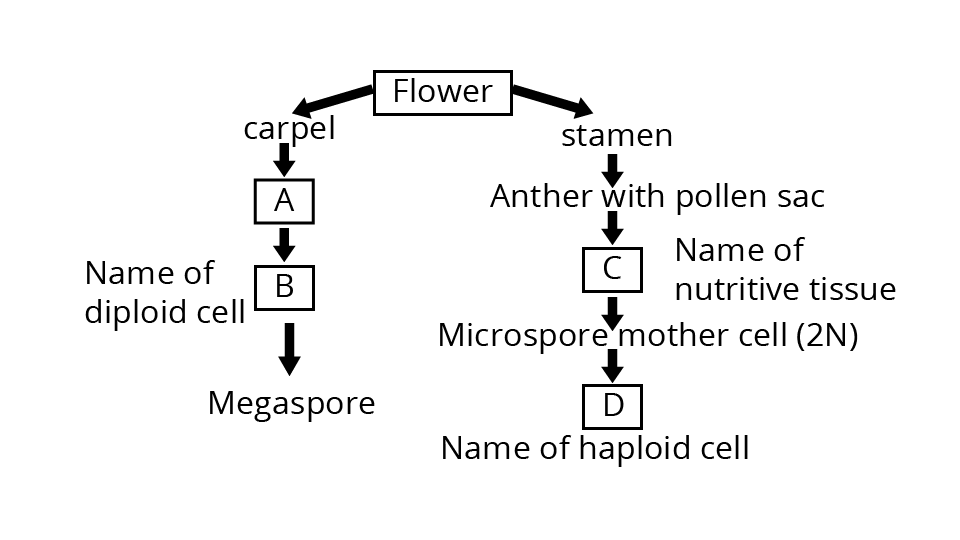
Ans: In the given flow chart
A represents Ovule/Megasporangium
B represents Megaspore mother cell
C represents Tapetum
D represents Pollen grains
9. Name the blank spaces a, b, c, and d in the table given below: Item What it represents in the plant.
Part | What it Represents in the Plant |
(i) Pericarp | a |
(ii) b | Cotyledon in seeds of grass family. |
(iii) Embryonal axis | C |
(iv) d | Remains of nucellus in a seed |
Ans: In the given table a, b, c, and d represents the following:
(i) Pericarp
Ans: a- wall of fruit
(ii) Cotyledon in seeds of the grass family
Ans: b-scutellum
(iii) Embryonal axis
Ans: c-shoot and root tip
(iv) Remains of nucellus in a seed.
Ans: d-perisperm
10. Even though each pollen grain has two male gametes. Why are at least 10 pollen grains and not 5 pollen grains required to fertilize 10 ovules present in a particular carpel?
Ans: This is because only one male gamete is involved in syngamy. ie fusion of male gamete with the egg cell.
11. Describe the structure of a microsporangium with a neatly labeled diagram.
Ans: The structure of the microsporangium is as follows:
-It is almost circular and it also has four wall layers.
-The outer three layers are epidermis, endothecium and middle layers are protective in nature and help in the dehiscence of anther so that it can release pollen grains.
-The inner tapetum provides food and nourishes the developing embryo. Sporogenous tissue remains at the central position.
12. Why can pollen grains remain well preserved as fossils?
Ans: Pollen grains are well preserved as fossils because the exine of the pollen is composed of a chemical, sporopollenin which can withstand high temperature, strong acids and alkalis, and strong enzymes
13. How are the cells arranged in an embryo sac?
Ans: An embryo sac is a 7 celled and 8 nucleated structure. A group of three cells is present at the micropylar end which are two synergids and one egg cell. The chalazal end has three cells, which are called antipodals. There is a central cell with 2 polar nuclei.
14. Why are cleistogamous flowers invariably autogamous?
Ans: In a cleistogamous flower, the flower never opens and when the anther dehiscence in the bud the pollen grains rest on the stigma of the same flower and therefore it is totally autogamous.
15. State any one advantage and disadvantage of pollen grains to humans.
Ans: Advantage: Pollen grains are rich in nutrients and therefore in lots of western countries, they( pollen tablets are used as food supplements.
Disadvantage: Pollens of many species of plants can cause severe bronchial afflictions and allergies which will usually lead to severe diseases like chronicle respiratory disorder.
16. State the characteristics of insect-pollinated flowers.
Ans: An entomophilous flower has the following characteristics:
• Petals and sepals are well developed with attractive colors to invite insects.
• Flowers are normally bigger in size with a strong odor.
17. Differentiate between chasmogamous and cleistogamous flowers
Ans:
Chasmogamous | Cleistogamous |
The flowers are conspicuous. The anthers and the stigmas are exposed. | The flowers are small and inconspicuous. The anthers and stigmas are never exposed. |
Both self and cross-pollination can occur. | Only self-pollination is possible |
18. Which type of pollination ensures the arrival of genetically different pollen grains 9 to stigma?
Ans: In xenogamy pollens from another plant of the same species pollinate the stigma and thereby ensure the coming of genetically different types of pollen grains onto the stigma.
19. What relationship exists between a species of moth and Yucca plant?
Ans: There exists a relationship between the Yucca plant and the moth. The moth deposits its egg in the locule of the ovary and in return moth pollinates the flower of the yucca plant. As the seeds begin to mature, the larvae hatch from the eggs.
20. Differentiate between Geitonogamy & Allogamy.
Ans: Below given are the Differences between Geitonogamy & Allogamy:-
Geitonogamy | Allogamy |
It takes place between anther & pistil of different flowers of the same plant. | It takes place between two flowers of two different plants of the same species. |
Bisexual flowers are essential for geitonogamy. | Unisexual flowers are essential for Allogamy. |
Progenies do not show variation & are genetically pure. | Progenies show variations & are genetically impure. |
21. Draw a diagram of L.S. of an anatropous ovule of an Angiosperm & label the following parts:-
(i) Nucellus
(ii) Integument
(iii) Antipodal cells
(iv) Secondary Nucleus.
Ans:
22. Why is the process of fertilization in flowering plants referred to as double fertilization?
Ans: In flowering plants, the first male nuclei fuse with the egg to produce a diploid zygote, and the second male nuclei fuse with the Secondary nucleus to produce the primary endosperm nucleus, resulting in DOUBLE FERTILISATION.
23. What are cleistogamous flowers? Can cross-pollination occur in cleistogamous flowers? Give a reason?
Ans: In some Angiosperm plants eg. Commelina, Oxalis, etc, flowers are bisexual and they never open. This condition is known as cleistogamy and flowers from this condition are called cleistogamous. The cleistogamous flowers are self-pollinated and to ensure this they never open. Hence, cross-pollination is not possible.
24. Draw a labeled diagram of mature embryo sac & label the following i) Egg cell ii) Antipodal cells iii) Synergids iv) Polar nuclei
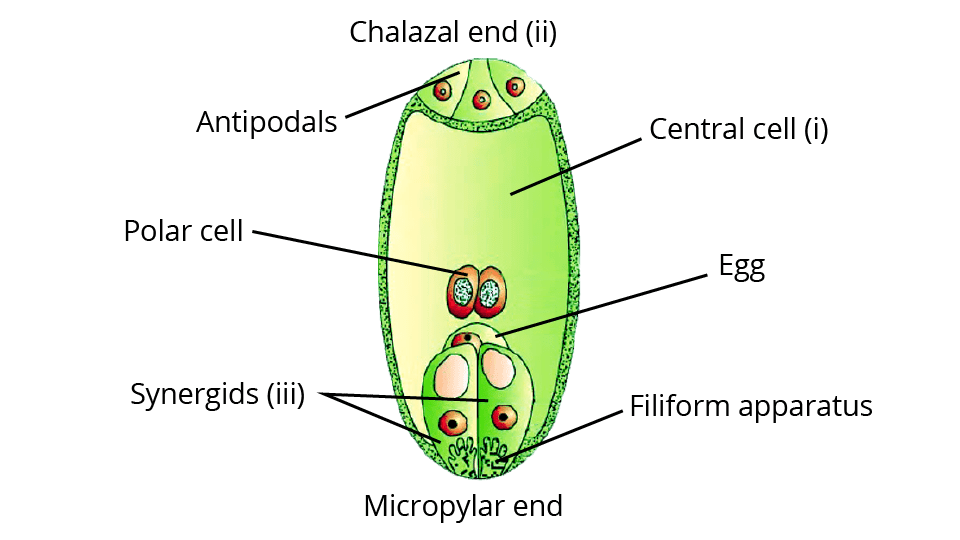
25. Mention two strategies evolved lay flowers to prevent self-pollination
Ans: Two strategies evolved lay flowers to prevent self-pollination
(i) Dichogamy - In this process, two reproductive organs of a bisexual flower mature at different- different times.
(ii) Self sterility – The Pollen grains couldn’t germinate on the stigma of the same flower or on the flower of the same plant.
26. What is apomixis? What is its importance?
Ans: The development of the reproductive propagules without meiosis and syngamy is known as apomixis. It is also known as asexual reproduction. apomixis is a method of reproduction that produces new individuals from the vegetative part of the plant body.
27. Draw a well-labeled diagram of a longitudinal section of a pistil showing pollen germination?
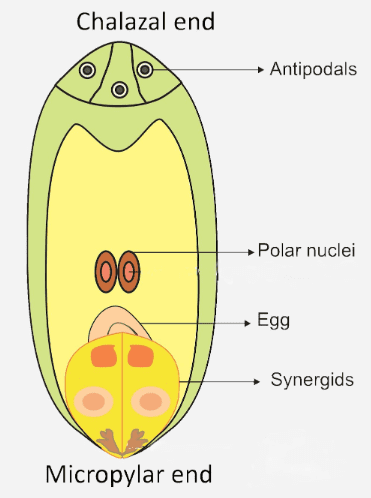
28. List the advantages of pollination to angiospermic plants?
Ans: Pollination leads to fertilization & production of seeds & fruits which are necessary for continuity of life.
i) It is critical for the development of new plant varieties.
ii) It is necessary for hybrid seed production.
iii) It aids in plant genetic recombination.
Long Answer Questions (3 Marks Questions)
1. Continued self-pollination leads to inbreeding depression. List three devices, which flowering plants have developed to discourage self-pollination?
Ans:
(a) Release of pollen and stigma receptivity is not synchronized in some species
(b) Anther and stigma are at different positions/heights in some plants
(c) Self-incompatibility is a genetic mechanism.
2. What will be the fate of the following structures in the angiospermic plant? Ovary wall, Ovule, zygote, outer integument Inner integument, and primary endosperm nucleus.
Ans: Ovary wall = Pericarp ; Ovule = Seed, Zygote - Embryo; Outer integument = Testa; Inner integument = Tegmen; Primary endosperm nucleus = Endosperm.
3. Differentiate between microsporogenesis and megasporogenesis. What type of cell division occurs during these events. Name the structure formed at the end of these two events.
Ans: Microsporogenesis is the process of production of microspore from a Pollen mother cell. Megasporogenesis is the process of production of megaspores from MMC. Meiotic division in both Microsporogenesis causes the formation of pollen grains while megasporogenesis causes the formation of megaspores.
4. Differentiate between microsporogenesis and megasporogenesis.
Ans: Below given are the differences between microsporogenesis and megasporogenesis:
Microsporogenesis | Megasporogenesis |
From the diploid microspore mother cell, haploid microspores or pollen grains are formed. | Megaspores are produced from the diploid megaspore mother cell. |
The pollen grains are arranged in a tetrahedral tetrad. | The megaspores are arranged in a linear tetrad. |
All the microspores are functional. | Only one megaspore is functional. Others degenerate. |
5. Explain the stages involved in the maturation of a microspore into a pollen grain.
Ans: The microspore comprises a dense cytoplasm and a bigger nucleus in the center. As the microspore develops the nucleus is shifted towards the side due to the production of vacuoles in the upper end of the cytoplasm. The mitotic division causes the nucleus to produce two nuclei which separate out into 2 cells; the lower generative cell and the upper bigger vegetative cell. A mature pollen grain normally has 2 cells.
6. What is triple fusion? Where does it occur?
Ans: The nucleus of a vegetative cell of pollen grain combined with 2 polar nuclei of the central cell of the female gametophyte joins to produce the primary endosperm. This fusion is called vegetative fusion or triple fusion because it involves 3 nuclei. It happens in the central cell of the egg apparatus.
7. Explain the structure of an anatropous ovule with a neat labeled diagram?
Ans: An anatropous ovule consists of: a stalk called a funicle attached to the placenta. Helium is the name for the connection between the funicle and the ovule. One or more integuments might enclose the ovule, with an aperture at the tip. The opening is called the micropyle. The opposite end of the micropyle is referred to as the chalazal end, the basal part of the ovule. Within the integuments that ordinarily contain a single embryo sac is a mass of cells known as nucellus.
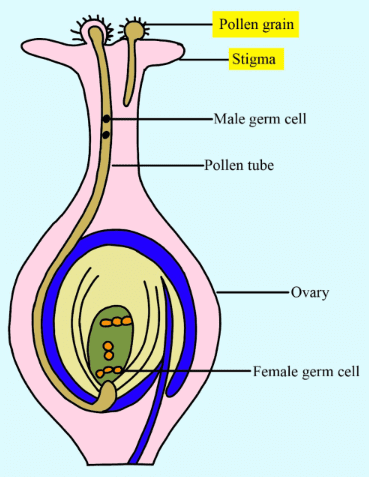
8. Describe the structure of a pollen grain.
Ans: The pollen grain is normally spherical with 2 wall layers.
The outer layer is exine composed of a highly resistant organic substance called sporopollenin which is absent at the aperture region called germ pore.
The inner layer is called the intine which is made up of pectin and cellulose.
A mature pollen grain has a vegetative cell and a generative cell.
9. Enlist the advantages offered by seeds to angiosperms.
Ans: The importance of seed formation:
Seed formation is linked with fertilization and pollination that are independent of water and therefore it is surely a more dependable process.
Seed formation provides nutrition and protection to the budding embryo.
Seeds are used for the multiplication of plants. Seeds are capable of perennation; they can withstand different climates.
10. Give any three advantages of sexual incompatibility.
Ans: Advantages of sexual incompatibility:
Sexual incompatibility inhibits self-pollination.
Sexual incompatibility has made plants outbreeders and thereby maintains the vitality and vigor of the plant’s rarace.
In sexual incompatibility, variations occur because outbreeding provides adaptability for the changes in the environment.
11. List any three differences between wind-pollinated flowers and insect-pollinated flowers.
Ans: Below given are the differences between wind-pollinated flowers and insect-pollinated flowers:-
Wind-Pollinated Flower | Insect-Pollinated Flower |
Flowers are small and colorless. | Flowers are brightly colored |
Flowers do not have scent or nectar | Flowers possess nectar glands. |
Pollen grains are dry and unwettable. | Pollen grains are sticky or Spiny. |
Stigma is a large well- exposed hairy and branched | Stigma is short and is present within the flower. |
12. Trace the development of microsporocytes into mature pollen grains.
Ans: When the anther is at an early stage of development, the microsporangium has closely arranged homogenous cells which form the Sporogenous tissues.
1. Each cell of sporogenous tissue will become a Pollen mother cell (PMC) and also forms microspore tetrad or Pollen grains.
2. But Some of them lose this Potential and later get differentiated into a pollen or microspore mother cell (MMC)
3. Every microspore mother cell (MMC) undergoes meiosis and produces a bunch of four haploid cells, which is called microspore tetrad.
4. When the anther gets matured, the microspores get dissociated from the tetrad and develop into pollen grains.
5. The mitosis happens in the nucleus of microspores to produce bigger vegetative cells and smaller generative cells. They form a double-layered wall – outer exine is made up of sporopollenin
And the inner intine is made up of cellulose and pectin. Generally, the pollen grains are released at two-celled stages.
13. i) Explain the structure of maize grain with the help of a diagram.
Ans: In the grass family ( eg. Maize ) fruit is single-seeded where the pericarp and the seed coat are fused together to produce the husk. Just below the husk, there is a layer of cells known as the aleurone layer, this layer stores protein. There is a large endosperm that stores starch. The embryo lies on one side of the endosperm & consists of a single cotyledon called scutellum & embryonal axis. The region of the embryonal axis that points downward from the point of attachment of cotyledons is a radicle and it is covered with a protective sheath known as coleorhiza. The region of an embryonal axis that points upward from the point of attachment of cotyledon is known as a plumule, it is covered by a foliaceous sheath called coleoptile.
ii) Why cannot we use the term maize seeds for maize grains?
Ans: We cannot use the term seeds for maize grain because the seed is not completely developed from the embryo but retains a part of the endosperm.
14. Trace the development of megasporocytes into the mature ovule.
Ans: (i) A single Megaspore mother cell is differentiated in the micropylar region of the nucleus of an ovule & undergoes meiosis & forms a cluster of haploid cells called megaspore tetrad. Of these, soon three degenerates & only one megaspore becomes functional
(ii) Functional megaspore enlarges to form embryo sac. Its nucleus undergoes mitotic division & two nuclei move to opposite poles forming a 2-nucleate embryo sac.
(iii) Two successive mitotic divisions in each of these two nuclei result in information of 8- nucleate embryo sac.
(iv) Three cells are grouped together at the micropylar end to form egg apparatus. consisting of two synergids & a female egg cell.
(v) Three cells are grouped together at the chalazal end, they are called antipodal cells.
(vi) The remaining two nuclei are called Polar nuclei, they move to the center of the embryo sac & fuse to form the secondary nucleus. Thus a typical angiosperm embryo sac is 8-nucleate 7-celled.
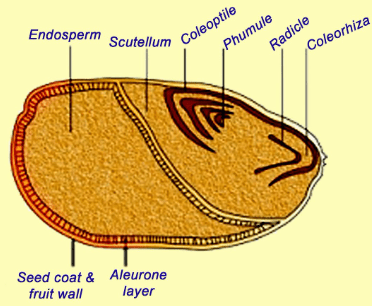
15. “Incompatibility is the natural barrier in the fusion of gamete”. Justify this statement.
Ans: Pollen grains of a plant species cannot germinate on the stigma of other non-related species as both the species are incompatible and the process is called pollen – pistil incompatibility. In many angiosperms plants, it is observed that pollen grains germinate on the stigma of non-related species but male gametes produced in pollen tubes cannot fertilize eggs. This is called gametic incompatibility. Self-incompatibility can be attained by utilizing any of the following ways:-
1. Pollen Stigma interaction: - In this phenomenon, pollen grains fail to germinate on Stigma because of incompatibility.
2. Pollen tube style interaction: - In this phenomenon, pollen grains become able to germinate on stigma & pollen tube penetrate stigmatic surface but due to incompatibility growth of pollen tube within stigma & style is inhibited.
3. Pollen – ovule interaction: - pollen tube successfully pierces & grows within style & its growth is inhibited at micropyle of ovule.
16. How does pollination takes place in salivia. List any four adaptations required for such type of pollination.
Ans: In salivia, entomophily/pollination of insects occur. The flowers of salivia are bilipped. Its upper lip consists of two petals and its lower lip consists of three petals. The lower lip is intended as a sitting pad for insects. In regular conditions, the connective stays upright. When the insect penetrates the tube of the corolla in the direction of nectar sitting on the lower lip, it pushes the sterile anther lobe which automatically brings about fertile anther to touch the backside of insects and gets the blow of the fertile lobe. Pollen grains are dusted on the back feathers and legs of insects
Adaptations Eor Entomophily Are :-
1. Flowers are brightly colored.
2. Flowers possess nectar glands.
3. pollen grains are usually sticky & spiny
4. flowers are large-sized & stout
Very Long Answer Questions (5 Marks Questions)
1. Draw the embryo sac of flowering plants and label :
(a) (i) Central Cell
(ii) Chalazal end
(iii) Synergids
Ans:

(b) Name the cell that develops into the embryo sac and explain how this cell leads to the formation of the embryo sac.
Ans: Megaspore mom cell (MMC) undergoes meiotic department to provide four megaspores. Out of these, three degenerates, and one useful megaspore develops into the embryo sac. This form of improvement is known as a monosporic improvement.
(c) Mention the role played by various cells of the embryo sac.
Ans: Egg: The egg fuses with a male gamete to make a zygote or future embryo, Synergid: Absorption of nutrients, it also attracts and guides pollen tubes. The Central Cell, after fusion with the second male gamete, makes primary endosperm cell also which gives rise to the endosperm.
(d) Give the role of filiform apparatus
Ans: Filiform apparatus guides the entry of pollen tubes.
2. Explain the formation of an embryo sac with diagrams.
Ans: The functional megaspore becomes bigger in size.
The mitotic division occurs in the nucleus to make 2 nuclei that go in direction of opposite poles.
Every nucleus at the poles undergoes two mitotic divisions to form 4 nuclei in each pole or a total of 8 nuclei.
Two nuclei from each pole move to the center to produce the polar nuclei.
The other nuclei, three at each pole, get surrounded by a bit of cytoplasm to form cells.
The female gametophyte or the embryo sac thus has 7 cells and eight nuclei.
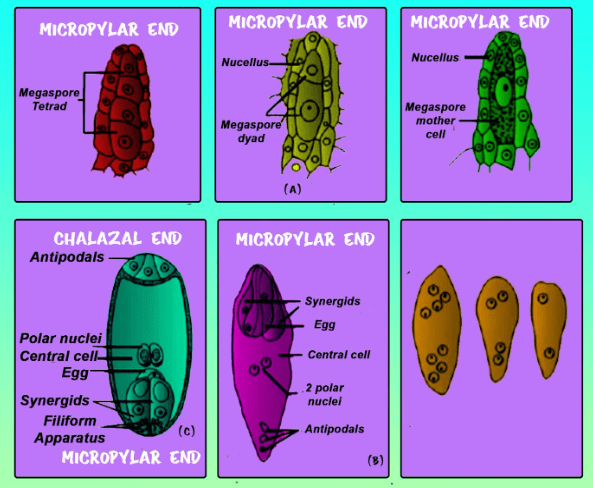
3. Explain the development of an embryo in a dicotyledonous plant with neatly labeled diagrams.
Ans: The embryo develops at the micropylar end where the zygote is located. The zygote begins developing after the particular part of the endosperm is developed to ensure nutrition to the embryo. The zygote breaks mitotically to develop several stages including pro- embryo, globular, heart-shaped, and eventually the developed embryo.
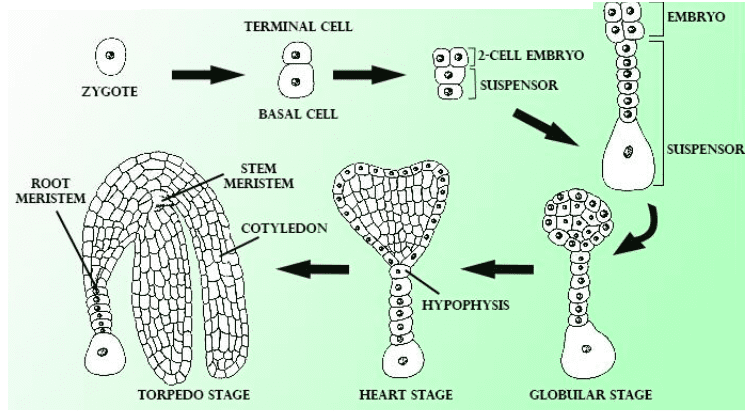
4. Describe the post-fertilization changes taking place in a flowering plant?
Ans:
(i) Development of Endosperm:- Endosperm development precedes embryo development. The most common method of endosperm development is the nuclear type where triploid endosperm (PEN) undergoes repeated mitotic divisions without cytokinesis – Subsequently cell wall formation occurs from the periphery & endosperm store food materials.
(ii) Development of Embryo:- The zygote divides by mitosis in a pro-embryo first. Later development causes the production of a globular and heart-shaped embryo & which ultimately becomes a horseshoe-shaped embryo with one or more than one cotyledon. In a dicot embryo, the portion of the embryonal axis about the level of attachment is epicotyl and it reduces into plumule while part of the embryonal axis below the level of attachment is hypocotyl and finally terminates into a radicle.
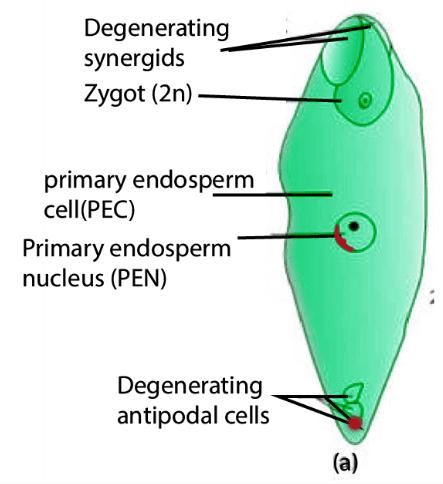
5. Trace the events that would take place in flower from the time of Pollen grain of species fall on stigma up To completion of fertilization.
Ans:
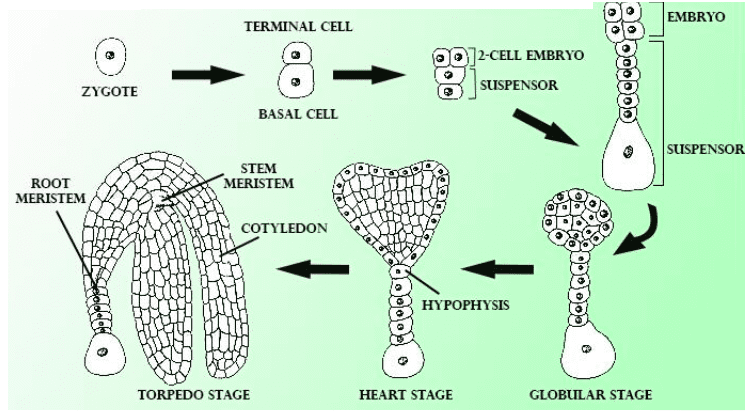
Germination of Pollen Grains on Stigma
The pollen grains absorb fluid present on stigma and swell up. The exine ruptures at the place of germ pore and intine come out in the form of a tube with its internal contents. This small tubular structure is called a pollen tube and the process is called pollen germination.
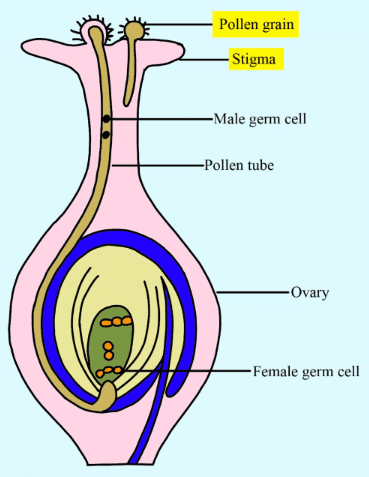
ii) Entry of pollen tube into Ovule: - The entry of pollen tube into ovule happens by the micropyle or chalaza or also by oblique sides of the ovule. Only 1 pollen tube begins inside the embryo sac of an ovule. Usually, two synergids are eliminated by the entry of a pollen tube into the embryo sac.
iii) Discharge of Mate Gametes:- Both male gametes are discharged into the embryo sac after entering the pollen tube, either by generating two pores in the pollen tube and releasing each male gamete through each pore or by the pollen tube rupturing and releasing the male gametes into the embryo sac.
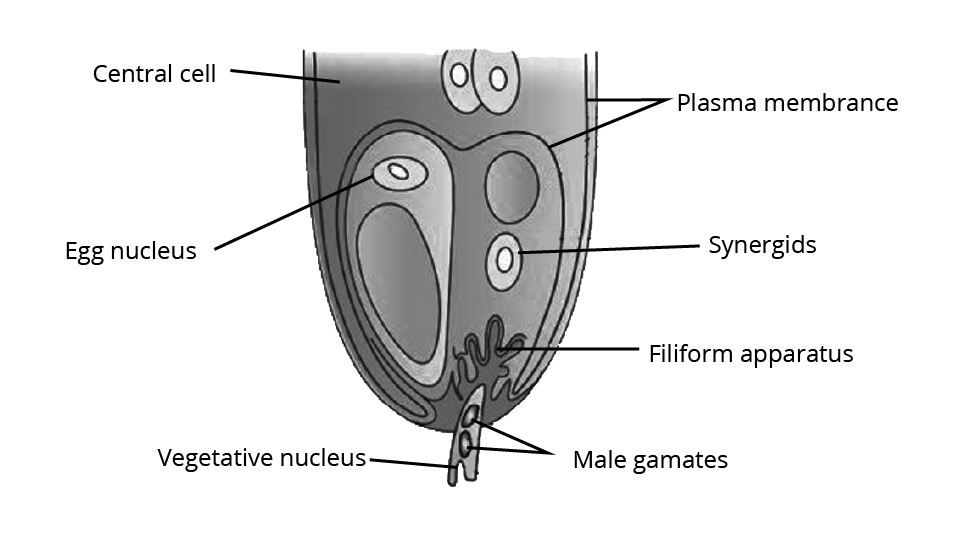
(4) Development of Embryo:- The zygote divides by mitosis into a pro-embryo first. After development outcomes in production of heart and globular shaped embryo and also that will eventually mature into an embryo of shapes of a horseshoe with one or more than one cotyledons.
In a dicot embryo, the part of the embryonal axis about the level of addition is called epicotyl and it eliminates into plumule while a portion of the embryonal axis under the level of attachment is known as hypocotyl and it terminates into the radicle.
6. i) Why are zygotes dominant for some time in the fertilized ovule.
Ans: Zygote stays dominant for quite some time in a fertilized ovule because the embryo develops after making of endosperm so zygote forms by the formation of endosperm which supplies food material for developing embryo.
ii) What is polyembryony? Give an example.
Ans: Polyembryony is known as the presence of more than one embryo in a seed, Example- Sometimes more than one embryo is created inside an embryo sac by the splitting of an egg or by cleavage, endosperm, synergid, or antipodal.
iii) In fruits, what is formed from the following parts:-
a) Ovary wall
b) Outer integument
c) Inner integument
d) zygote
e) primary endosperm
f) Ovary
g) Nucellus
Ans: In fruits, the following things are formed from given parts:
a | Ovary wall | Pericarp |
b | Outer integument | Testa |
c | Inner integument | Tegmen |
d | zygote | embryo |
e | primary endosperm | endosperm |
f | Ovary | fruit |
g | Nucellus | perisperm. |
Important Questions for Class 12 Biology Chapter 1
Why is Chapter 1 Important for Students?
Chapter 1 of Biology Class 12 deals with Sexual Reproduction in Flowering Plants. This is a slightly difficult chapter but students can easily learn and understand it if they study properly from our website. This chapter is crucial because many questions are given from here in the final examinations. Also, sexual reproduction in flowering plants has a considerable weightage in competitive examinations later on.
Relevance of Chapter 1
Plant reproduction is necessary because it helps plants to produce small offsprings. Plant reproduction may be sexual or asexual. Sexual reproduction occurs with the fusion of gametes in plants.
Students must learn about these as they will help them understand plant reproduction better as well as help them conduct lab experiments on them. They must clear their bases before going into further studies about them.
Why is it Important to Study Class 12 Biology Chapter 1 Important Questions from Vedantu?
It is important to study Class 12 Biology Chapter 1 important questions from Vedantu because students can get all possible help from our website. Not only the important questions, but also study notes, class notes, and revision notes are available so that students can refer to those to understand and study the chapter in a better way. Our experts have also conducted online classes which are saved on our website for a better understanding. Diagrams are provided along with step by step explanations of the solved solutions for the best preparations possible.
How to Study for Chapter 1 Sexual Reproduction in Flowering Plants
We suggest students follow the pattern below for the best possible preparation before examinations
Study the study notes and class notes as given on our website, and make own notes from it.
Study the diagrams carefully and draw them individually for a better understanding of the topics.
Solve the important questions of chapter 1 biology class 12 so that students know the various types of questions which might appear in the examinations.
Why Choose Vedantu?
Vedantu is a student-friendly platform that provides a one stop solution to all students’ questions about their syllabus. Our website is designed in such a way that students can get all the answers and step-by-step explanations of all the questions they are looking for. We also have the study notes, revision notes, and important questions in downloadable PDF format so that students can study anywhere and anytime they want.
We make sure that our experts who write the solutions are well-trained with immense knowledge about the subjects they write on. They make sure that the written materials are clear, simply written so that it is easy for students to learn. They carefully go through the syllabus given by the board, NCERT solutions, and the previous year’s question papers so that students get access to all the possible questions that might appear in the examinations.
Introduction to Sexual Reproduction in Flowering Plants
Reproduction in plants refers to the birth of their offspring. Reproduction may be sexual or asexual.
Angiosperms or flowering plants use a sexual mode of reproduction. This reproduction method involves male and female gametes that are present in the flower. Even if some parts of the flowering plants are sterile, they still help in the reproduction process.
In this chapter, we will study the different parts of the flower to understand their nature and the function they have in the reproduction process.
The Entire Flower Consists of
Pedicel
Sepals
Petals
Calyx
Stamen i.e. the male reproductive part containing the anther and filament
Pistil i.e. the female reproductive part containing stigma. Style, and ovary.
Topics Included under Sexual Reproduction in Flowering Plants
The topics that we will discuss here are -
Pre-Fertilization Structure and Events
In the pre-fertilization stage, the male and the female reproductive parts i.e. the androecium and the gynoecium diffuse and change. The male and female parts are discussed below-
Stamen, Microsporangium, and the Pollen Grains
The stamen consists of two parts namely the filament and the anther. The filament is a long slender stalk while the anther is a bilobed structure with each lobe containing two thecae which makes them dithecous.
The anther is tetragonal and consists of microsporangia which are situated at the edge and each lobe contains a pair of them.
The microsporangia is the fusion of microspores through the process of meiosis from a pollen mother cell. The microsporangia develop into the pollen sacs.
The pollen grains are the male gametophytes. The pollen grains mature to form two types of cells vegetative and generative cells.
Pistil, Megasporium, and Embryo Sac
The gynoecium i.e. the female reproductive part of the flower may be monocarpellary or multicarpellary. Each of the pistils consists of a stigma or the landing area of pollen grains, tyle or the long slender area below the stigma, and the ovary i.e. the pistil’s bulged section.
The ovarian cavity is commonly known as the oculus. Here, the placenta is present from where the megasporangia emerge.
The ovule is made up of hilum, micropyle, funicle, integuments, chalaza, nucellus, and embryo sac.
The process of formation of megaspores from the megaspore mother cell or MMC is known as Megasporogenesis.
Generally, only one of the four megaspores is functional and evolves into the female gametophyte or embryo sac. The rest of them degenerate.
A typical angiosperm upon maturity has 8 nucleated but is 7 celled on reaching maturity.
Stages of Sexual Reproduction in Plants
A flower is referred to as unisexual or bisexual based on the presence of stamen and pistil, or just stamen or just pistil.
Sexual Reproduction in Flowering Plants Occurs in Three Stage
Pollination - Pollination is a process where the pollen grains are transferred across the anther and the stigma of the same flower of one plant or among the flowers of different plants. This results in the fertilization and production of seeds. These pollen grains are transferred by birds, wind, animals, and water.
There are three kinds of Pollination namely Autogamy, Geitonogamy, and Xenogamy.
Formation of a Zygote - After the pollination process is over, the male gamete gets transported down the style of the pistil to the ovary. Here, the male gamete fuses with the female one to produce a zygote. The embryo develops and the zygote splits after some amount of endosperm is produced. This helps to provide nutrition to the developing embryo.
Formation of Fruits and Seeds- The zygote develops in the embryo after its formation. In the meantime, the ovules transform into seeds while the ovary develops into a fruit. The formation of seeds takes place with the fruits. This formation of seeds depends on other reproductive processes like pollination and fertilization. Also, this process is dependent on water. Seeds have a very adaptive strategy that helps them to colonize other areas. Young seedlings are self-sufficient and can nourish themselves. The new seeds also contain new genetic combinations that result in variations. The seeds thus formed may be stored for future use for almost up to a year.
Conclusion
To conclude, we can say that sexual reproduction in plants is a crucial chapter for students in class 12. Not only are they important for school examinations and board exams, but they also have considerable weightage in many competitive exams as well. So, we at Vedantu ensure that students get their hands on all the required study notes, revision notes, and the Biology Class 12 Chapter 1 important questions. This will make sure that students study and revise thoroughly and know all the different types of questions that might appear in the examinations. This will help them familiarize themselves with the questions thus saving precious time during exams and fetching good marks both in the finals and the competitive exams later on.
Related Study Materials for Class 12 Biology Chapter 1
S.No | Important Other Links for Class 12 Biology Chapter 1 |
1. | |
2. | CBSE Class 12 Sexual Reproduction in Flowering Plants Solutions |
CBSE Class 12 Biology Chapter-wise Important Questions
CBSE Class 12 Biology Chapter-wise Important Questions and Answers cover topics from Other chapters, helping students prepare thoroughly by focusing on key topics for easier revision.
Additional Study Materials for Class 12 Biology
FAQs on CBSE Important Questions for Class 12 Biology Sexual Reproduction in Flowering Plants - 2025-26
1. What are the most frequently asked important questions from Chapter 1 Sexual Reproduction in Flowering Plants in the Class 12 Biology board exam?
Key important questions often involve:
- Structure and functions of parts of the flower (anther, ovary, ovule)
- Differences between microsporogenesis and megasporogenesis
- Steps in double fertilization and its significance
- Adaptations for pollination (wind, water, insect)
- Explanation and diagrams of embryo sac development and dicot embryo structure
2. How should students approach answering long answer questions based on diagrams, such as the L.S. of an ovule or structure of anther, for Class 12 Biology Chapter 1?
For diagram-based questions:
- Practice neatly labeled diagrams as per NCERT standards.
- Start with a well-drawn outline using a sharp pencil.
- Label all required parts clearly and accurately.
- Accompany your diagram with a concise explanation of the structure and function of each labeled part.
3. Why is double fertilization considered a unique event in flowering plants, and how is it typically tested in board examinations?
Double fertilization is unique to angiosperms as it involves one male gamete fusing with the egg (syngamy) to form a zygote, and the other male gamete fusing with two polar nuclei to form the endosperm (triple fusion). In exams, you may be asked to define, describe the process, draw a diagram, or explain how it contributes to seed and fruit development. Expect this as a common 3-mark or 5-mark question.
4. What conceptual traps should students avoid when preparing important questions from Sexual Reproduction in Flowering Plants?
Common conceptual errors include:
- Mixing up the roles of male and female gametophytes
- Confusing apomixis (asexual seed formation) with double fertilization
- Incorrectly labeling or explaining embryo sac structures
- Assuming all pollination types (xenogamy, geitonogamy, autogamy) are genetically equivalent
5. How are important questions from Chapter 1 selected for the Class 12 Biology board exam according to CBSE trends?
Questions are selected based on:
- Current CBSE syllabus and weightage for reproductive biology
- Past 5–10 years’ board exam papers to identify frequently repeated questions
- Inclusion of HOTs (Higher Order Thinking Skills) and application-based questions
- Emphasis on understanding of concepts, diagrams, and sequential steps
6. What are the typical marks weightage and sub-topic breakdown for important questions in Sexual Reproduction in Flowering Plants for board exams?
Generally, this chapter carries around 8–10 marks in the CBSE Biology paper. Subtopics with greater weightage include:
- Structure and function of reproductive organs
- Mechanisms of pollination and fertilization
- Development of seed and fruit
- Application-based questions involve polyembryony, apomixis, and seed dispersal adaptations
7. In what ways do important questions from this chapter integrate with higher-level exams such as NEET and why should students focus on them early?
Many important questions in CBSE Biology Class 12 on sexual reproduction overlap with NEET/entrance exam concepts, especially those testing conceptual clarity, diagram interpretation, and genetic reasoning. Early and thorough practice with these questions builds a strong foundation and sharpens analytical skills necessary for competitive exams beyond school board tests.
8. How are concepts like apomixis and polyembryony framed as important questions, and what key points should answers include?
If asked about apomixis or polyembryony, include:
- Definition with an example
- Biological significance (e.g., genetic uniformity, seed formation without fertilization)
- Comparison with normal sexual reproduction
9. What strategies help students efficiently revise all important questions from Sexual Reproduction in Flowering Plants before the board exam?
Effective strategies include:
- Creating summary notes or flashcards for each key concept
- Solving previous year and sample important questions under timed conditions
- Practicing diagrams with clear labels
- Reviewing common errors in past answers
- Focusing on the application and reasoning in HOTs questions
10. What is a common misconception about the relationship between pollination and fertilization, and how should students address this in important questions?
A frequent misconception is to treat pollination and fertilization as the same process. Pollination is the transfer of pollen grains to the stigma, while fertilization is the fusion of gametes to form a zygote. In board exams, separate each process in answers and highlight their sequential relationship for full marks.
























